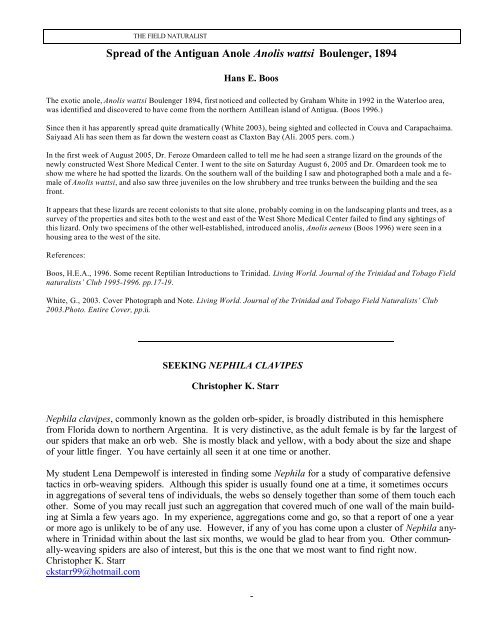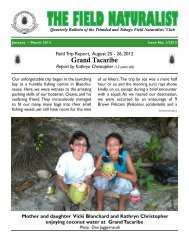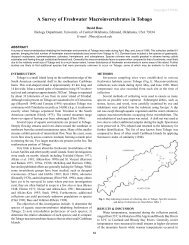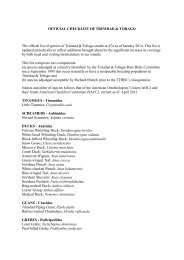THE FIELD NATURALIST(Morpho peleides), Postman (Heliconius melponene) which is only common in <strong>Trinidad</strong> <strong>and</strong> <strong>Tobago</strong>(Stiling 1986), <strong>and</strong> the Monarch (Danaus lexippus). <strong>The</strong> latter is a cosmopolitan species whose distributionincludes North <strong>and</strong> South America, Australia <strong>and</strong> the East Indies (Stiling 1986). Strong migratorytendencies are displayed by this species in temperate countries but not in the tropics (Stiling 1986).Spiders seen along the trail in the vegetation were Azilia vachoni <strong>and</strong> Leucage sp.(Tetragnathidae). A minute yellow spider of the family <strong>The</strong>ridiosomatidae was observed. It builds a smallmodified orb-web, characteristic of this family. <strong>The</strong> middle is held up with a tight thread to form a cone.When a prey gets caught, this thread is released <strong>and</strong> the web springs back entangling the prey (Levi <strong>and</strong>Levi 2002).After about 1½ hours <strong>and</strong> crossing two water filled gorges with sheer rock walls on either sidereaching over 4m, we reached Covigne Waterfall. Quite a magnificent sight with water pouring oversheer rock wall, this waterfall st<strong>and</strong>s at about 4m high. But this was easily scaled with the aid of a rope.Our final destination was the Covigne Pool located about 3m above the waterfall. Scooped out from therock this pool measured about 9m in diameter with a depth of about 2m in the middle. <strong>The</strong> trail eventuallyleads to Mount Destre.We had lunch at the pool <strong>and</strong> some members opted for a quick dip. Clusters of bright orange-redflowers of the Cooperhoop or Mountain rose (Brownea latifolia) were seen on the banks of the river. Thissmall, evergreen, understory tree can reach a height of 8m <strong>and</strong> is common in moist forests (Quesnel <strong>and</strong>Farrell 2000), which explains its presence on the banks. After lunch we were treated to slices of Mammeeapple (Mammea americana) courtesy of Dan Jaggernauth. A native to the Caribbean, this large roundfruit has brown skin <strong>and</strong> a sweet orange-red pulp which could be eaten raw or cooked (Hargreaves <strong>and</strong>Hargreaves 1965). Each fruit contains 2 to 4 large oblong, reddish-brown seeds. In Mexico the seeds <strong>and</strong>juice are used as insecticides (Hargreaves <strong>and</strong> Hargreaves 1965). <strong>The</strong> 2.5cm long fragrant white flowersare used in the French Caribbean in a liqueur called “Eau de Créole” or “Créme de Créole” (Hargreaves<strong>and</strong> Hargreaves 1965). Mervyn added that it is alleged that if one were to consume alcohol after eating itthis would cause an upset stomach in both the light <strong>and</strong> heavy drinker.On the way back, quite a few species of spiders were seen along the banks of the river buildingtheir webs on overhanging vegetation or under earth banks. Species included Mesabolivar aurantiacus(Pholcidae) <strong>and</strong> an unidentified species of the family Tetragnathidae. Argiope sp. (Araneidae) was alsoseen. <strong>The</strong>se build an orb-web incorporating thick b<strong>and</strong>s of silk into a pattern. This characteristic featureof the web is called a stabilimentum but it is sometimes omitted from the web (Kaston 1972). This speciesmade three regularly spaced concentric circles radiating from the centre. <strong>The</strong> individuals of somespecies were seen minus their webs, such as one belonging to the family Pisauridae which was seen onthe rocks lining the river. Members of this family can walk over water by spreading their legs radially.Another was Micrathena sp. (Araneidae). We ended our walk past an old ammunition bunker, a remnantof the American naval base. Afterwards, some members took a quick dip in one of the manmade waterfallswe had seen at the beginning of the trial.References:Bourne, M.J., Lennox, G.W. <strong>and</strong> Seddon, S.A. 1993. Fruits <strong>and</strong> vegetables of the Caribbean. MacMillan Caribbean. London.9p.Hargreaves D <strong>and</strong> Hargreaves B. Tropical Trees Found in the Caribbean, South America, Central America, Mexico. HargreavesCompany. 1965. 16-17, 23, 46pKaston, B.J. 1972. How to Know the Spiders. 2 rd ed. Dubuque, Iowa. 144pLevi, H.W. <strong>and</strong> Le vi, L. R. 2002. A Guide to Spiders <strong>and</strong> their Kin. Golden, NewYork. 70pQuesnel V.C. <strong>and</strong> Farrell T.F. Native Trees of <strong>Trinidad</strong> <strong>and</strong> <strong>Tobago</strong>. <strong>Trinidad</strong> & <strong>Tobago</strong> <strong>Field</strong> Naturalists’ <strong>Club</strong>. 2000. 34,91, 143pStiling P.D. 1986. Butterflies <strong>and</strong> other insects of the Eastern Caribbean. Macmillan Education Ltd. London. 63, 73p.8
Spread of the Antiguan Anole Anolis wattsi Boulenger, 1894Hans E. Boos<strong>The</strong> exotic anole, Anolis wattsi Boulenger 1894, first noticed <strong>and</strong> collected by Graham White in 1992 in the Waterloo area,was identified <strong>and</strong> discovered to have come from the northern Antillean isl<strong>and</strong> of Antigua. (Boos 1996.)Since then it has apparently spread quite dramatically (White 2003), being sighted <strong>and</strong> collected in Couva <strong>and</strong> Carapachaima.Saiyaad Ali has seen them as far down the western coast as Claxton Bay (Ali. 2005 pers. com.)In the first week of August 2005, Dr. Feroze Omardeen called to tell me he had seen a strange lizard on the grounds of thenewly constructed West Shore Medical Center. I went to the site on Saturday August 6, 2005 <strong>and</strong> Dr. Omardeen took me toshow me where he had spotted the lizards. On the southern wall of the building I saw <strong>and</strong> photographed both a male <strong>and</strong> a femaleof Anolis wattsi, <strong>and</strong> also saw three juveniles on the low shrubbery <strong>and</strong> tree trunks between the building <strong>and</strong> the seafront.It appears that these lizards are recent colonists to that site alone, probably coming in on the l<strong>and</strong>scaping plants <strong>and</strong> trees, as asurvey of the properties <strong>and</strong> sites both to the west <strong>and</strong> east of the West Shore Medical Center failed to find any sightings ofthis lizard. Only two specimens of the other well-established, introduced anolis, Anolis aeneus (Boos 1996) were seen in ahousing area to the west of the site.References:THE FIELD NATURALISTBoos, H.E.A., 1996. Some recent Reptilian Introductions to <strong>Trinidad</strong>. Living World. Journal of the <strong>Trinidad</strong> <strong>and</strong> <strong>Tobago</strong> <strong>Field</strong>naturalists’ <strong>Club</strong> 1995-1996. pp.17-19.White, G., 2003. Cover Photograph <strong>and</strong> Note. Living World. Journal of the <strong>Trinidad</strong> <strong>and</strong> <strong>Tobago</strong> <strong>Field</strong> Naturalists’ <strong>Club</strong>2003.Photo. Entire Cover, pp.ii.SEEKING NEPHILA CLAVIPESChristopher K. StarrNephila clavipes, commonly known as the golden orb-spider, is broadly distributed in this hemispherefrom Florida down to northern Argentina. It is very distinctive, as the adult female is by far the largest ofour spiders that make an orb web. She is mostly black <strong>and</strong> yellow, with a body about the size <strong>and</strong> shapeof your little finger. You have certainly all seen it at one time or another.My student Lena Dempewolf is interested in finding some Nephila for a study of comparative defensivetactics in orb-weaving spiders. Although this spider is usually found one at a time, it sometimes occursin aggregations of several tens of individuals, the webs so densely together than some of them touch eachother. Some of you may recall just such an aggregation that covered much of one wall of the main buildingat Simla a few years ago. In my experience, aggregations come <strong>and</strong> go, so that a report of one a yearor more ago is unlikely to be of any use. However, if any of you has come upon a cluster of Nephila anywherein <strong>Trinidad</strong> within about the last six months, we would be glad to hear from you. Other communally-weavingspiders are also of interest, but this is the one that we most want to find right now.Christopher K. Starrckstarr99@hotmail.com9








